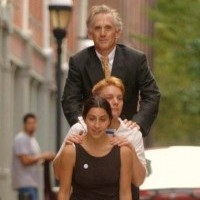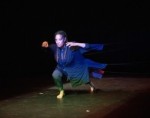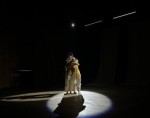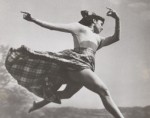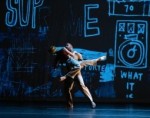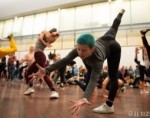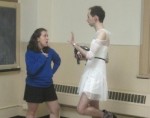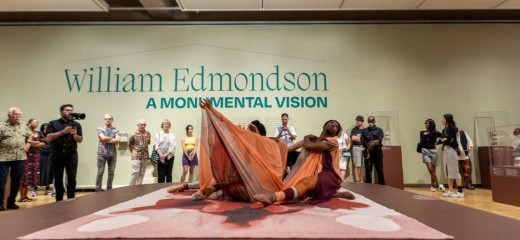
Traversing a Monumental Vision
by Jonathan Stein and Patricia Graham
For its major exhibition of the self-taught sculptor William Edmondson (c. 1874–1951), the Barnes Foundation has invited multi-disciplinary visual and movement artist Brendan Fernandes to create an original performance and installation in response to Edmondson’s life and work. The exhibition William Edmondson: A Monumental Vision, through September 10, presents more than 60 of Edmondson’s works. Considered one of the most important Black American artists of the early 20th century, Edmondson was the first Black artist to have a solo exhibition at the Museum of Modern Art in 1937.
Inspired by a heavenly vision—“I knowed it was God telling me what to do. God was telling me to cut figures”—Edmondson at age 60 began carving tombstones and then created minimalist limestone sculptures. He described these as “mirkels,” with figuration drawn from his culture and community: religious icons, nurses, teachers, preachers and public figures, and animals from rural Tennessee. As art historian Leslie King Hammond writes in the exhibition catalogue: “He channeled his intellectual prowess into the creation of a very different modernism—inspired by an African American perspective—that was marginalized in his own time and is still slighted today.”
Fernandes’ response performance Returning to Before intends to center the spirituality within Edmondson’s life and work and create a “spiritual ground for inclusivity,” according to his pre-performance talk and catalogue essay. In the large gallery space, Edmondson’s carved community congregates around Fernandes’ abstractly designed, raised altar-like woven textile (titled More Than Action), a sanctuary ground for his dancers for this hour-long, balletic performance.
Jonathan Stein and former tD writer Patricia Graham offer this exchange of impressions following the debut performance of Returning to Before on July 14.
Patricia Graham: I was blown away by Edmondson’s work. The sculptures need to be seen in person. They have so much presence, humor, and life to them that doesn’t translate in photographs. The sculptures serve as a record that reflects a complex community of individual lives and shared belief.
Jonathan Stein: I too was gob-smacked by this exhibition. Although I have seen individual Edmondson work in isolation over the years, this grand grouping is a glorious affirmation of his life’s work and community. The dancers’ beginning was a highpoint for me, the four dancers (Mikal Gilbert, Tiffany Mangulabran, Brena Thomas, and Allison Walsh) entering with their diaphanous, breezy, church choir-like gowns of pale orange, beige, and maroon (designed by Katrin Schnabl). They immediately engaged with individual Edmondson works, returning the gaze of the figures and sometimes mirroring their pose or character as when, for example, Philadanco dancer Gilbert kneeled on one bent knee, his other bent leg angled away, before Seated Girl with Folded Legs (c. 1934). As some of us in the audience circulated with the dancers (most of the audience, unprompted, never circulated), we became part of the dynamic engagement between the dancers and Edmondson. My attention turned to the women dancers in pointe shoes tapping their steps on the hardwood floor. It was the pointe shoes and other formal elements of classical ballet in the performance that seemed a bit bizarre to me in contrast to the grounded minimalist figuration of the Edmondson work.
Do you think the dancing effectively connected to Edmondson?
PG: I most saw the connection in the beginning, as you described, when the dancers took their time in relating to individual sculptures. It resonated with deep reverence and care, like personal greetings across time and space as the dancers communed with specific figures. When they continued their dance on the central altar with its woven textile the intimate communication dissolved, and the dance became more removed and symbolic. I found myself noting the ways in which this solemn ballet approach, with its seriousness and formality, contrasted with the sculptures. I didn’t see the joy, the individual stories, and the sly renderings of personality present in Edmondson’s work, but I did see a sustained homage to the master sculptor.
JS: I agree, in part, that Fernandes’ ballet approach was jarring in contrast to the Edmondson works. The choreographic concept of meditation and stillness among his dancers did not fully embrace the complexity and breadth of Edmondson’s societal renderings, or his humor and whimsicality (the mischievous Nurse Wooten, described in the catalogue “on the pot”, c.1935; Mermaid c.1932-1941). Some of the poses adopting a stylized artifice seemed out of place with the artwork, like one dancer with head cocked back supported by a bent arm, gazing into the beyond.
Yet I was captured by many still moments created by the four dancers which resonated with the serenity amongst Edmondson’s extended carvings of people and animals. When the dancers enveloped themselves in the shifting forms of their multi-hued costumes, something quietly enchanting emerged in the concealing and revealing of bodies and limbs. When the ballet formalisms were set aside for the quartet of dancers standing at rest with outstretched open palms, they achieved a spiritual and physical communion with Edmondson, and with this viewer.
PG: I agree, the piece evolved as it became more rooted in gesture and spatial relationships among the dancers. What stood out for me was the rhythm between movement and stillness, repeated over time. The repetition and the attentiveness, requiring endurance and persistence, perhaps were the qualities reflected back to Edmondson in appreciation across the years.
JS: I wished the audience might have shown the same attentiveness and persistence. At least three-quarters of the audience left by the hour’s end. Perhaps it was the pre-performance oral instructions that they could leave to eat and drink outside; perhaps the performance did not meet audience expectations. More audience nurturing might be in order for such on-site, in-gallery performances. This would be my recommendation since the director of the Barnes, Thom Collins, states in the press release that, “This exhibition…marks the first in a series of collaborations that elevate the role of performance in exhibitions. Recognizing the interpretive potential for performance to build new pathways into historical art, we are…placing performance at the heart of exhibition development.” This statement, and the fact that the Fernandes performance will be repeated twice on each Saturday until Sept. 2 is to be applauded. To realize its aspirations here, maybe the Barnes’ next step should be to hire a curator of performance.
PG: I’m also happy to see on-going performances commissioned in partnership with the exhibit. Generally, ballet dancers train and perform in relation to a proscenium environment which frames and highlights the forms they create and produces a wall behind which the audience watches. I sensed this fourth wall presence here between dancers and the audience in the gallery. This theatrical paradigm, which we hold culturally, affects the expectations of the audience and directs their behavior. Many artists have explored the softening of the performative fourth wall and intentionally create works that immerse the audience directly in the action. There are many gradients in approach to performance that the Barnes can explore in their programming. Looking forward to their next steps.
Returning to Before, choreographed and designed by Brendan Fernandes, Saturdays through Sept. 2.
William Edmondson: A Monumental Vision the Barnes Foundation, through Sept. 10.
By Jonathan Stein
August 6, 2023

